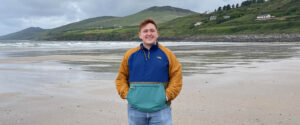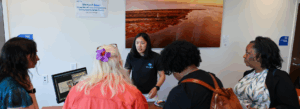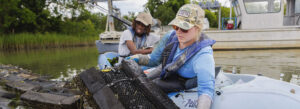Blue Crab Blues: Will ocean acidification cause growing pains for baby crabs?
Before blue crabs grow large enough to end up on a dinner plate, they must first avoid being eaten by larger fish and birds—or even other blue crabs. But environmental conditions, like dead zones without oxygen and acidifying waters, also threaten blue crabs’ survival.
Acidic water can affect the protective shells blue crabs grow as they mature to adulthood, but how will acidic conditions affect a crab’s earliest life stages?
Almost no research has investigated this question, so Christina Fantasia-Buscher, a Ph.D. candidate at University of Virginia’s department of environmental sciences, wanted to understand how acidic waters might change blue crab development through her Virginia Sea Grant Graduate Research Fellowship.
“Her research is unique as far as the effects of acidification,” said Stephen Macko, a professor of environmental sciences at UVA. “We’re picking up the signals of changing chemistry, and with the acidity that’s coming, there may not be sufficient time for crabs to adapt.”
Each female crab can carry anywhere from three million to five million eggs on a sponge-like bed on its belly. In early summer, the female crabs carry their fertilized embryos out to the saltier water in the mouth of the Bay. Normally, it takes about 14 days for the blue crab embryos to hatch from their eggs and “graduate” to a free-swimming larval form called zoea. These tiny zoeae are swept out in the ocean for the first month of their life before ocean currents carry them back into the Bay during the fall.
For her fellowship research, Fantasia-Buscher studied blue crab embryos and zoeae to see how acidic water changed their development. She tracked how fast the crabs reached different stages of development, their egg shape, and their heart rate. She kept the embryos and zoeae in water spanning from current ocean conditions, with a pH of 8.1, all the way to a highly acidic pH of 6.8—what Fantasia-Buscher calls an “extreme scenario.”
“I’m looking through the entire progression of development from as early as I can get them to when they hatch,” Fantasia-Buscher said. “I’m also looking at hatching success, and seeing how many are hatching in the various conditions.”
Under the microscope, the blue crabs she studies look like “armored mosquitoes”—a far cry from the iconic blue crabs that scavenge the floor of the Chesapeake Bay and that watermen pull up in crab pots. But if acidic conditions cause embryos to die before they hatch, there may be fewer baby blue crabs returning to the Bay.
“They have a lot of cultural value, they have a lot of commercial value, and they’re important in an ecological sense as well,” Fantasia-Buscher said. “Finding out what they would do in future scenarios for the ocean could help a lot of watermen.”
So far, Fantasia-Buscher has found that more zoeae died under conditions with higher acidity. She also found that the embryos and zoeae raised in acidic conditions developed more slowly. If these blue crabs take too long to hatch and grow, they might be too late to catch the surface currents that bring them back into the Chesapeake Bay.
“They have a lot of cultural value, they have a lot of commercial value, and they’re important in an ecological sense as well,” Fantasia-Buscher said.
While a small number of the late-hatching embryos might ride other currents back to smaller inlets or North Carolina’s Pamlico Sound, Fantasia-Buscher said these crabs are more likely to end up as “yummy snacks” for other fish out in the ocean. She is continuing to analyze the embryo growth rates and the level of calcium in the zoea shells to determine how ocean acidification might affect these very young blue crabs.
Growing these delicate, vulnerable crabs for research can be tricky—normally a mother crab in the wild would keep the eggs clean and free of parasites. In the lab, Fantasia-Buscher must keep parasites and bacteria off the eggs through frequent water changes and the use of anti-fungal chemicals.
“It’s very difficult to work with embryos because they get so easily infected, so figuring out what exactly to use, and how much to use, and all that sort of stuff is part of the process,” Fantasia-Buscher said.
After she completes her research, Fantasia-Buscher plans to become a teacher and use her experience to spark the curiosity of the next generation of scientists.
Takeaways:
- Blue crab embryos may experience delayed development due to ocean acidification, and less embryos may survive and hatch.
- Christina Fantasia-Buscher studies how the earliest life stages of the blue crab are affected by acidic water conditions as a VASG Graduate Research Fellowship and Ph.D. candidate at UVA.
- If freshly hatched blue crabs don’t grow fast enough, they may not develop in time to ride ocean currents back into the Chesapeake Bay.
- Ocean acidification may impact very young blue crabs, not just the juvenile and adult blue crabs in the Bay.
Photos and video by Aileen Devlin | Virginia Sea Grant
Story by Madeleine Jepsen | Virginia Sea Grant
Published Feb. 21, 2020.
“I’m looking through the entire progression of development from as early as I can get them to when they hatch,” Fantasia-Buscher said.
“We’re picking up the signals of changing chemistry, and with the acidity that’s coming, there may not be sufficient time for crabs to adapt,” Macko said.





